
“It was a sight surpassing all precedent, and one we never dreamed of seeing.”
Howard Carter

Courtesy of National Geographic:
For more than three thousand years, few individuals other than Egyptologists were aware of the ancient Egyptian royal named Tutankhamun. The name had appeared only on a few monuments and small finds, and the pharaoh’s final resting place seemed to have eluded discovery. In a single turn of events that occurred almost a century ago, the name recognition of that pharaoh changed overnight. Tutankhamun quickly became one of the most familiar of all the pharaohs who ruled ancient Egypt, joining the ranks of Khufu, whose pyramid is one of the seven wonders of the ancient world, Ramesses, whose name is associated with the biblical Exodus, and Cleopatra, Egypt’s female ruler, whose links to and eventual battles with Rome almost changed the history of the Western world.

“Possente Ftha” from “Aida” by Giuseppe Verdi (courtesy of EnricodelConte47):
Howard Carter (1874 – 1939) was an English archaeologist who made one of the richest and most celebrated contributions to Egyptology, the discovery of the tomb of Tutankhamun. He was the son of a portrait artist, and his first endeavours in Egyptology were as a painter and draughtsman rather than as an excavator. At the age of seventeen, he joined his first expedition to Egypt working as an artist. His progression was swift, however, and in 1899 he was appointed the first chief inspector of the Egyptian Antiquities Service. By 1907 he was conducting his own excavations, financed by the Earl of Carnarvon.
The sensational discovery of the tomb of Tutankhamun in 1922 brought Carter worldwide fame and re-created an interest in the glories of ancient Egypt. The task of clearing the contents of the tomb took ten years and, when complete, Carter turned to other researchers. He also travelled throughout Europe and America, giving lectures on the discovery.
Courtesy of Buster Birch, the oldest trumpets in the world, discovered in Tutankhamun’s burial chamber, played for the first time in over 3000 years during a BBC broadcast in 1939:
In recognition of his achievements, Yale University conferred upon Carter the honorary degree of Sciences, and the Real Academia de la Historia of Spain made him an honorary member. He was the author of several books on Egyptology, and a frequent contributor to scientific journals.
 Fascination with Egypt and its many wonders is not a modern phenomenon, and one of the longest, apart from India, surviving civilizations of the ancient Near East was a focus of interest even in ancient times. Foreign visitors to its land often left graffiti on the walls of Egyptian monuments, and royalty and wealthy Roman citizens sought prized Egyptian statuary to display at home. Those who lived beyond its borders were captivated by stories and reports of the practice of mummification on humans and animals, powerful pharaohs supposedly descended from gods, a religion with hundreds of divinities in various forms, supplies of gold that that seemed unending, a river that ran in a different direction, and unparalleled monumental stone structures that soared skyward. Its fabled treasures, hidden well below the surface of its sands, had lured many admirers, both native and foreign, and by modern times, most of the royal tombs and a good portion of the private burials had experienced the ravages of tomb robbers.
Fascination with Egypt and its many wonders is not a modern phenomenon, and one of the longest, apart from India, surviving civilizations of the ancient Near East was a focus of interest even in ancient times. Foreign visitors to its land often left graffiti on the walls of Egyptian monuments, and royalty and wealthy Roman citizens sought prized Egyptian statuary to display at home. Those who lived beyond its borders were captivated by stories and reports of the practice of mummification on humans and animals, powerful pharaohs supposedly descended from gods, a religion with hundreds of divinities in various forms, supplies of gold that that seemed unending, a river that ran in a different direction, and unparalleled monumental stone structures that soared skyward. Its fabled treasures, hidden well below the surface of its sands, had lured many admirers, both native and foreign, and by modern times, most of the royal tombs and a good portion of the private burials had experienced the ravages of tomb robbers.
Time passed, and interest in Egypt ebbed and peaked; then, at the end of the eighteenth century, it reached a new high in Europe. As part of Napoleon’s expedition to North Africa, he had assembled a scientific and artistic commission consisting of experts in many fields to record everything they saw. Their many reports, articles, and volumes provided the public with more than glimpses of Egypt’s amazing civilization: they gave life to its material remains. With the world’s exposure to these important ancient treasures, tourism increased, and soon museums, travellers, diplomats, and wealthy patrons sought examples of the country’s fascinating objects to display in their collections.
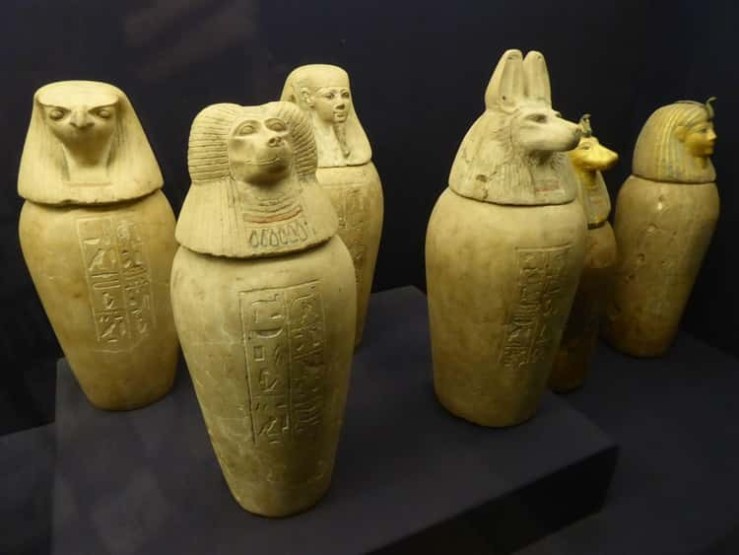
The excavations required substantial financial support. Funds came through a variety of sources such as government subsidies, institutional grants, and support from foundations and wealthy private individuals. When Carter met Lord Porchester (Earl of Carnarvon), he found that they shared a common interest in ancient Egypt. Carter’s extensive training fitted in well with Carnarvon’s desire to participate in professional archaeological excavation as a private backer. By the summer of 1914, Carter and Carnarvon secured a concession and by the end of that year had plans for their investigations and began mapping their strategy. Carter chose an area that he felt might reasonably have contained the tomb he and Carnarvon sought. Therefore, he determined that the central section of the Valley of the Kings was the most promising area.

Almost immediately, issues outside their control affected their plans, the First World War had begun in Europe, and Carnarvon returned to England and remained there for the duration of the war. Carter stayed in Egypt spending much of his time on war efforts, although he occasionally involved himself in some archaeological work. Finally, in the autumn of 1917, Carter began excavating in his original intended area.
“O patria mia” from “Aida” by Giuseppe Verdi, performed by Leontyne Price (courtesy of vicmanu):
By 1922, six seasons had passed with little to show. Undaunted, Carter felt that one last season might bring success. Lord Carnarvon, however, had a different mindset. He was no longer sure that their collaborative efforts would succeed. The costs had been high, and he sent a message to Carter asking him to meet at his English residence, Highclere Castle. The Earl then informed him that he could no longer continue supporting the excavation. Although under extreme pressure, Carter had a strategy: he would finance the last season himself. If he found success, then whatever he discovered would belong to Lord Carnarvon. Impressed with Carter’s resolution and dedication, the Earl reversed his original position and told him that he would support a final season.
A fateful decision! Not long after, Carter would make history.
Highclere Castle in Newbury, Berkshire

“Downton Abbey (Main Theme)” by John Lunn (courtesy of Jessie Conran):
His seventh season began on 3 November 1922, and by the third day, his team excavated several of the structures. After recording and making plans, Carter removed them. The next day, when he arrived at the site, he did not see the customary bustle of work, nor did he hear the accompanying din of the workmen; there was only silence. Something must have happened!
His head man quickly brought him to see what looked like a single step cut into the rock; he continued clearing, then revealed that it was the first of sixteen in a staircase that appeared to lead to a tomb. It was not until late the next day, that the upper part of a sealed doorway was exposed. Eventually, Carter was able to see the well-preserved sealing of the necropolis that had been impressed in the wet plaster thousands of years earlier. A corridor almost filled to the ceiling with rubble lay behind. While thoughts that he might have discovered his dreams rushed through his mind, he wondered what the conditions of the tomb would be. With incredibly determined reserve, he stopped work and quickly cabled Carnarvon: “At last have made wonderful discovery in the Valley; a magnificent tomb with seal intact; re-covered same for your arrival; congratulations.”
Lord Carnarvon and his daughter Lady Evelyn Herbert quickly sailed for Egypt, and then on the 26th of November, they accompanied Carter down the steps and through the corridor. They stood nearby as he made a tiny hole in the door and inserted a candle into the first of the four chambers of the tomb. When questioned by his anxious patron as to whether he could see anything, Carter uttered what may rank as one of the world’s greatest understatements: “Yes, wonderful things!”
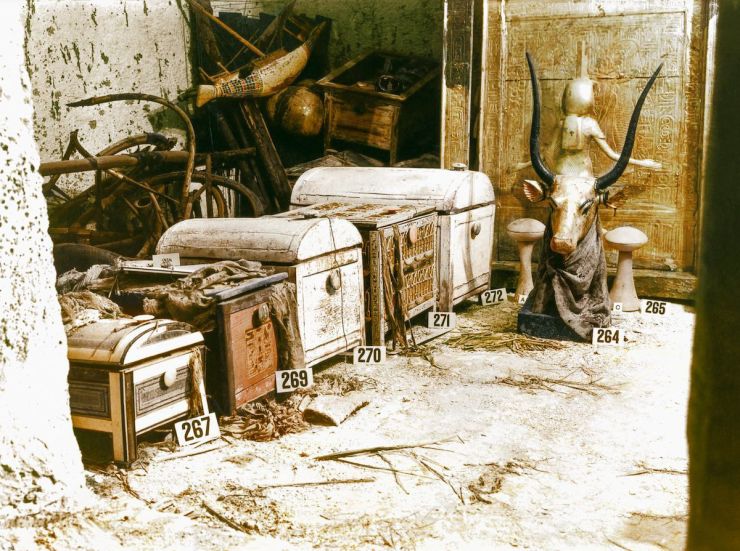

Courtesy of The Discovery of King Tut:
The real work then began. Carter had discovered an intact tomb with an astounding total of more than five thousand artefacts It was a pharaoh’s treasure which Carter described as “Everywhere gold!” Carter had quickly put together a team of the best specialists to aid him in clearing, recording, documenting, and preserving the tomb and its contents. About one month later, they began work. On 17 February, several dignitaries, officials, and Egyptology colleagues stood near as Carter and Carnarvon removed the sealed doorway between the rooms. What they revealed was what Carter described as “a solid wall of gold” less than a metre away. There were four gilded shrines surrounding the nested solid gold coffins that protected the body of Tutankhamun.
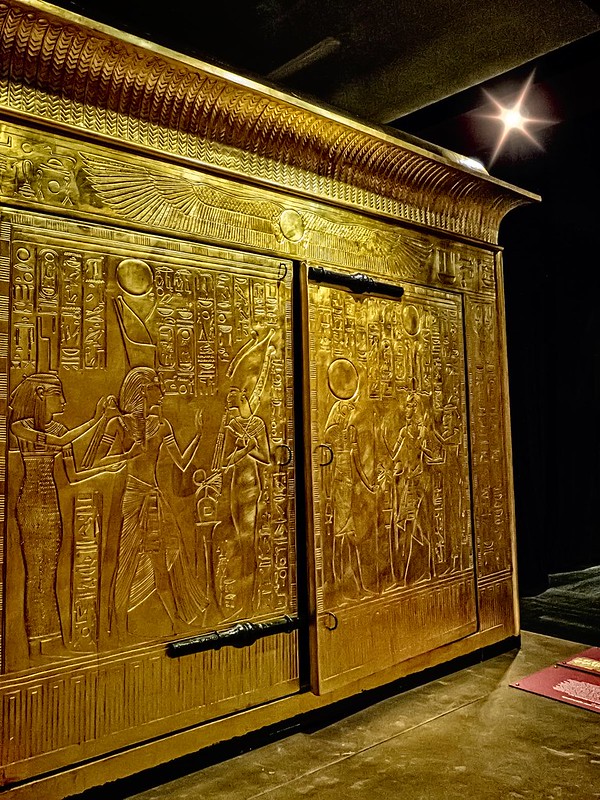
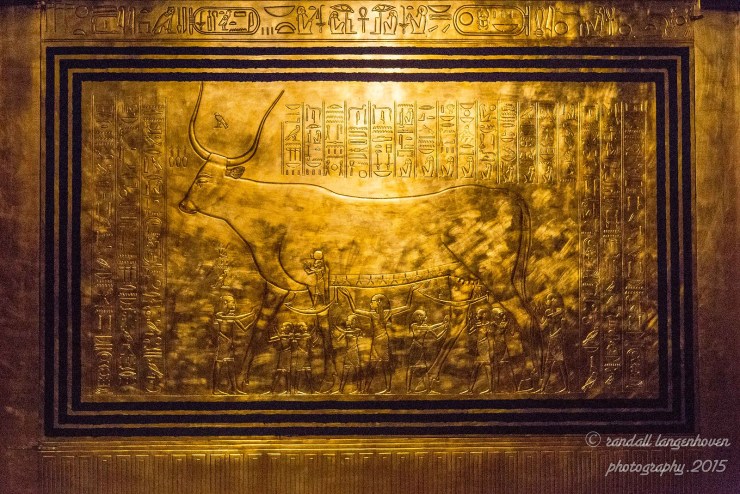


Courtesy of The Discovery of King Tut:
Carnarvon, however, never lived to see the mummy of the young king. Succumbing first to fever, then infection, and finally to pneumonia, he died shortly thereafter, on 5 April 1923. According to many newspaper reports, the Earl’s death was attributed to an inscription supposedly carved on the wall of one of the golden shrines in the Burial Chamber:
“They who enter this sector tomb shall swiftly be visited by the wings of death.”
While experts quickly rejected such misinformation and noted the inaccuracies contained in these stories, the public preferred the myth. Thus, the “Curse of Tutankhamun” began. Out of 58 who were present when the tomb and sarcophagus were open only eight died within a dozen years. Howard Carter who was most responsible for finding and opening the tomb died of Lymphopenia in 1939. Among the supposed victims of the curse was Prince Ali Kamel Bey of Egypt, shot dead by his wife in 1923, Sir Archibald Douglas Reid, who supposedly X-rayed the mummy and died in mysterious circumstances, and Sir Lee Stack, the governor-general of the Sudan who was assassinated in Cairo in 1924.
Courtesy of Wild Dream Films:
In truth, the often-quoted curse did not appear in the tomb or on any of its contents. While the Egyptians did use curses, the Tutankhamun curse bore no resemblance to the usual form at all.
The only items that Carter found in the tomb that could conceivably have given rise to the story were a group of magical bricks: inscribed amuletic objects that were meant to protect the deceased from any evil. Still, articles and books on the curse of Tutankhamun proliferated. Without any basis, the myth took on a life of its own, and it has survived now for more than 90 years. Even Hollywood took part, producing several films based on this, beginning with The Mummy in 1932.
 The ancient Egyptians tried to achieve immortality through many and varied practices, and believed that repeating a person’s name – “causing the name to live” – meant that the memory of the dead would live on, ensuring a form of immortality. No act of the living has likely succeeded in perpetuating the name of Tutankhamun as did Carter and Carnarvon’s discovery of the tomb of the boy king. At the time, it inspired a revival of Egyptomania, a phenomenon in which the influence of the pharaoh was expressed in all aspects of popular culture: art and design, architecture, songs, films, clothing, cosmetics, perfumes, even cocktails. Now, nearly a century later, millions of people have visited Egypt to see his tomb and treasures have read the books and articles, seen the films, and played computer games based on the event. In addition, treasures from the tomb have been the focus of several international exhibitions of Egyptian antiquities from 1962 until now, allowing even more people to have access to the wonders of Tutankhamun. The king’s name has now been repeated manifold times and will continue to be so in the future.
The ancient Egyptians tried to achieve immortality through many and varied practices, and believed that repeating a person’s name – “causing the name to live” – meant that the memory of the dead would live on, ensuring a form of immortality. No act of the living has likely succeeded in perpetuating the name of Tutankhamun as did Carter and Carnarvon’s discovery of the tomb of the boy king. At the time, it inspired a revival of Egyptomania, a phenomenon in which the influence of the pharaoh was expressed in all aspects of popular culture: art and design, architecture, songs, films, clothing, cosmetics, perfumes, even cocktails. Now, nearly a century later, millions of people have visited Egypt to see his tomb and treasures have read the books and articles, seen the films, and played computer games based on the event. In addition, treasures from the tomb have been the focus of several international exhibitions of Egyptian antiquities from 1962 until now, allowing even more people to have access to the wonders of Tutankhamun. The king’s name has now been repeated manifold times and will continue to be so in the future.
Tutankhamun can indeed rest in peace; his wish for immortality has been granted, and as Tutankhamun’s discoverer, Howard Carter’s memory is etched in history.
“Old King Tut” by Billy Jones and Ernest Hare from 1923 (courtesy of Bob Marvin):

One of the early explorers presented is Emily Sands, who after attending Howard Carter’s lecture “The Mummy’s Course – Fact or Fiction” in London in 1925, sailed for Egypt to do some research of her own. Her journal arrived by post from Aswan to Patsy’s Hotel Cairo, where it was lying forgotten in a storeroom for over eighty years. When discovered in 1994 it was purportedly posted to Emily Sand’s relative, Joanna Sutherland (nee Sands).
What is interesting is that Emily Sands and her team disappeared without a trace and what happened to her and her team was never discovered. As one of the Keepers of Egyptian Antiquities at the British Museum wrote to Joanna Sutherland: “.. the mysterious disappearance of the party is very puzzling. I am not a believer in mummy curses, but the world is not without other, more prosaic, manifestations of malevolence. “
The journal which was beautifully published a few years ago is a fascinating document of her finds, and she wrote about her impressions in her journal:
“The pyramids reminded me of all I came to Egypt to discover – the dusty tombs, the ornate temples, the golden treasures, and the strange, unearthly mummies, but I have also come to find something more.” What she wanted to discover was the tomb of Osiris, but then she vanished. I will leave it to the interested reader to decide whether the journal is solely a work of fiction or more…
 The journal is full of Emily Sands’ delightful illustrations as she could draw and paint very well. The details she included are described precisely, from the head covering of the kings, the mummification process, the games played, the many religious ceremonies, including reciting the chapters from The Egyptian Book Of The Dead.
The journal is full of Emily Sands’ delightful illustrations as she could draw and paint very well. The details she included are described precisely, from the head covering of the kings, the mummification process, the games played, the many religious ceremonies, including reciting the chapters from The Egyptian Book Of The Dead.
The game she described and illustrated was called Senet and needed two players, a board, 10 playing pieces of 5 spools and 5 cones, 4 counting sticks – plain on one side, decorated on the other. Although, in her delightful illustrations she drew a lion playing Senet with a gazelle, on the wall painting there is a picture of queen Nefertari playing Senet inside a tomb so she could relieve her boredom after her death.

In ancient Egypt, pharaohs and other important people were mummified after they died as the Egyptians believed that a person could only make the journey to the afterlife if their body was preserved. The process of mummification is described in detail, and it was an elaborate and complicated process that took many weeks. I am going to spare you the way the brain was removed, and you can be thankful for this! First, the internal organs, which decompose quickly after death, were removed from the body. Only the heart was left inside as the ancient Egyptians believed that the dead could not make the journey to the next world without their heart. The body was then filled with a mix of spices and stitched closed. Next, the body was left to soak in a solution called natron for 40 days. The final step in the mummification process was to wrap the body in long strips of linen. Gold and jewels were placed into each layer of linen. A scarab beetle was placed over the heart. Internal organs were placed in special jars called canopic jars. Some animals like sacred cats were also mummified.
Here is a picture of the mummification of a pharaoh by the god Anubis, patron of embalmers, shown on a wall painting.
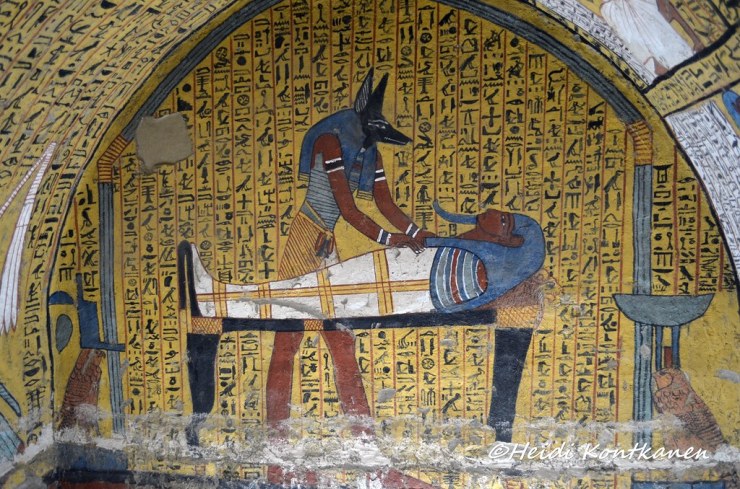
The importance of the Nile River cannot be overestimated. Food grown along its banks fed people all over Egypt. The river created an oasis in the middle of the desert. The papyrus made from a plant that was growing on the banks of the Nile River was used for hieroglyphic writing, a complex system that uses many symbols, not letters.
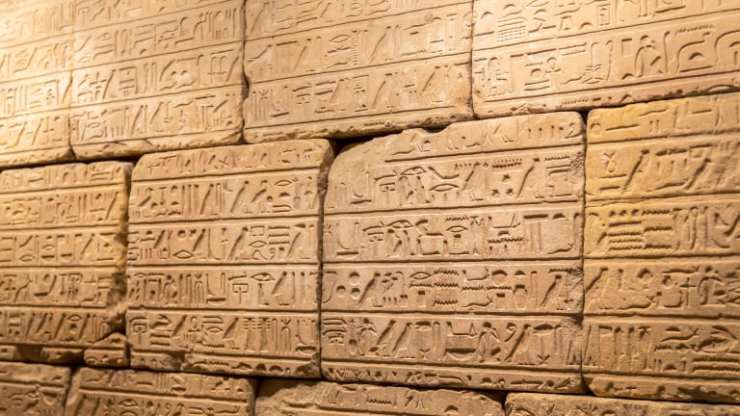 The construction of pyramids and temples was a highly skilled and imaginative process. The entire construction was surrounded by a huge ramp, which was used to raise the stone blocks to the top of the rising pyramid. Stones were transported by river and purposely built canals from nearby quarries. More than 30,000 workers built each of the largest pyramids over several decades. The massive and heavy stone blocks used to build pyramids were raised into position with specially built cranes that were equipped with a stone counterweight to make them more stable, and by this were easier to manoeuvre.
The construction of pyramids and temples was a highly skilled and imaginative process. The entire construction was surrounded by a huge ramp, which was used to raise the stone blocks to the top of the rising pyramid. Stones were transported by river and purposely built canals from nearby quarries. More than 30,000 workers built each of the largest pyramids over several decades. The massive and heavy stone blocks used to build pyramids were raised into position with specially built cranes that were equipped with a stone counterweight to make them more stable, and by this were easier to manoeuvre.
The Egyptians erected high columns, called obelisks in their temples The base of the obelisk had holes, and sand would drain out through these holes. As the sand emptied, the obelisk slowly would rise and sink into place.
 One of the most beautiful temples is found in Luxor. It was decorated with brightly coloured scenes from pharaohs’ lives.
One of the most beautiful temples is found in Luxor. It was decorated with brightly coloured scenes from pharaohs’ lives.
I have to mention the Sphinx, the statue of a reclining lion with the head of the pharaoh Khafra as it has become a symbol of Egypt. It is believed to have been built more than 4,000 years ago. It is 21 metres high, and it is facing east, the direction in which the sun rises, so that it could welcome the god Ra every morning.
 The ancient Egyptians worshipped many gods but the most significant were Ra and Horus. Horus was the god of kingship and the heavens. The pharaohs were considered Horus’ representatives on earth. The Eye of Horus is a symbol of health, strength, and renewal.
The ancient Egyptians worshipped many gods but the most significant were Ra and Horus. Horus was the god of kingship and the heavens. The pharaohs were considered Horus’ representatives on earth. The Eye of Horus is a symbol of health, strength, and renewal.
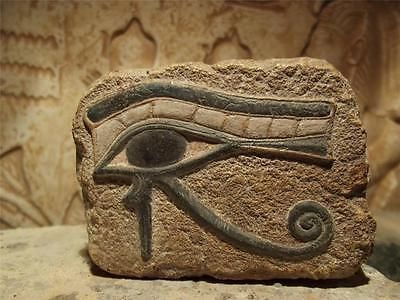 I hope that after reading this post, a visit to Egypt (post-pandemic) will be on your list of places one must see before one dies.
I hope that after reading this post, a visit to Egypt (post-pandemic) will be on your list of places one must see before one dies.
Thank you, Cheryl, for your wonderful comments! It is such a pleasure to read your kind words! Greatly appreciated!
Joanna
LikeLike
Really enjoyed your article. My great grandfather, Valentine Geere, was also an English archaeologist around the same time (1874-1923). He wrote “By Nile and Euphrates” about his “adventures”. Fascinating time!
LikeLike
Thank you for your fascinating comments! I didn’t know that you are, presumably, English and perhaps live in the United Kingdom.
If you can, please, write to me at my email address:
naturetailsuk@gmail.com
and tell me your name. Also, is the book your great-grandfather wrote still possible to buy?
Joanna
LikeLiked by 1 person
Thanks Joanna, I have sent you some info.
LikeLike
Interesting read Joanna, thank you for sharing. I’m fascinated with all I’ve read and a visit to Egypt for sure highlighted on my wish list.
LikeLiked by 1 person
Thank you, Henrietta, for your lovely comments. Greatly appreciated.
Joanna
LikeLiked by 1 person
Incredibly informative, great photos and video choices. Really interesting to read thank you 😀
LikeLike
Love reading such informative posts. I learn so much whenever I visit your blog, Joanna
Thanks🤍
LikeLike
Thank you for your kind comments. Greatly appreciated.
Joanna
LikeLiked by 1 person
Wow! Such beauty. Such history. Thank you for sharing.
LikeLike
Thank you for your kind comments. Greatly appreciated.
Joanna
LikeLiked by 1 person
Great job Jo❤️
LikeLike
Thank you!
Joanna
LikeLiked by 1 person
I am still amazed how you find these rare images and detailed stories. I am now listening to the record about King TUT! . Fascinating! 🖖🏾 👏
LikeLike
Thank you for your kind comment!
I read a lot and that is how I find interesting facts.
Your praise is greatly appreciated!
Joanna
LikeLiked by 1 person
If anyone needs research on any subject…you are the “goto” person! 💎
LikeLike
Thank you! I agree as I love finding the answers to any questions.
Joanna
LikeLiked by 1 person
Hi there! It’s a pleasure to come back to your blog after a long time and what an incredible article you’ve jotted down about the boyish pharaoh Tutankhamun! We even had a chapter on Tut in standard 11 last year and everything about him and his life including his death, his marriage with his half-sister, and the pharaoh’s curse possess an utmost mystery. Enjoyed the read yet again. Thanks!!
LikeLike
Thank you, Shayan, for your lovely comments and welcome back after a long absence. I am happy that you are now well and your last poem is magnificent! I think you will like my science series,
and if time allows, please have a look.
Thank you again, Shayan, greatly appreciated.
Joanna
LikeLike
I first heard of “King Tut” from my mother who was age 10 when his tomb was opened. I believe she did a school project on the event and it locked in many of the details. Thanks so much for re-revealing in detail so much of that history in this blog for your readers. Tutankhamun’s discovery was clearly the high point of Egyptomania of the day. Times have changed for archeologists in that cultural treasures now rarely leave the country of their origin – and sadly with the destructive potential of weapons used in today’s conflicts, are frequently lost to the rest of the world. Stewart
LikeLike
Thank you, Stewart, for your kind comments. I was always fascinated by the way immortality was acievaded by people. Tutankhamun was one extraordinary example, and I had to write about. One day I will write about Francis d’Assisi whose life made such an impact on the world. Thank you again, Stewart, your words are very much appreciated.
Joanna
LikeLike